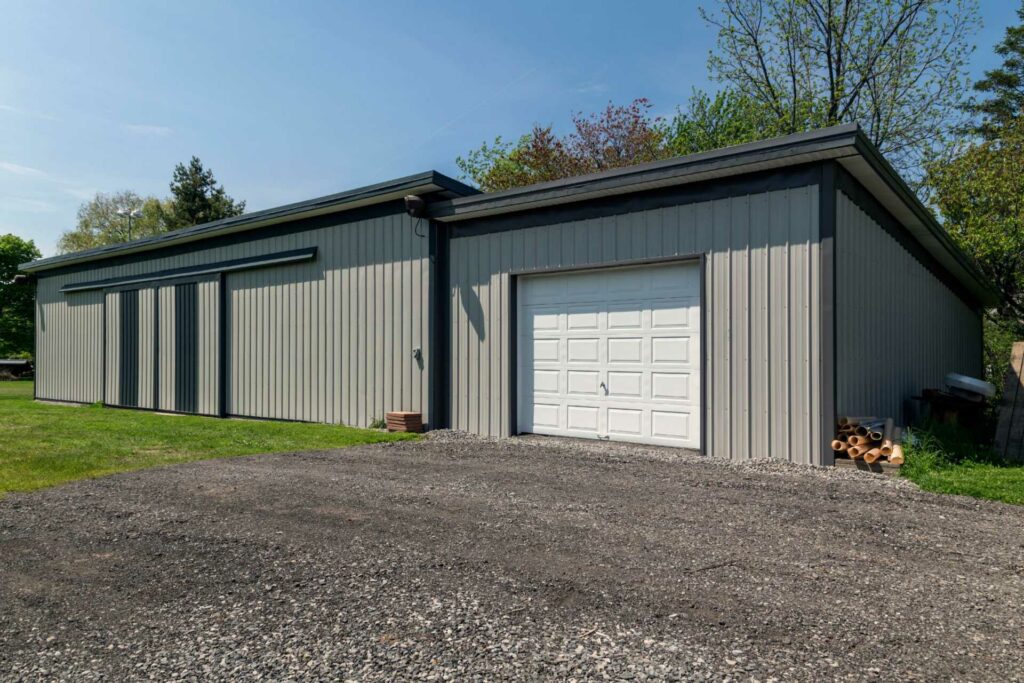
Contents
Imagine this: a modern metal building standing under the scorching sun, yet inside, it remains cool and comfortable without relying heavily on energy-consuming systems. From insulated metal roofing to energy-efficient windows, there are key architectural features that can transform the energy efficiency of metal structures. Want to learn how these elements work together to create eco-friendly and cost-effective buildings that prioritize both comfort and environmental responsibility?
Key Takeaways
- Insulated Metal Roofing with integrated insulation options for reduced heat transfer and improved thermal performance.
- Energy-Efficient Windows with low U-Factor, SHGC ratings, and high VT values for optimal energy savings.
- Cool Roofing Systems with reflective properties to lower heat absorption and reduce cooling costs.
- High-performance insulation techniques for stable indoor temperatures and minimized heat transfer.
- Natural Ventilation Designs for airflow enhancement, passive cooling, and energy consumption reduction.
Insulated Metal Roofing
For optimal energy efficiency in metal buildings, consider installing insulated metal roofing to minimize heat transfer and improve thermal performance. When it comes to roofing materials, insulated metal roofing stands out as a top pick for energy savings. By incorporating insulation options within the metal panels, you can greatly reduce the amount of heat that enters or escapes the building, leading to lower energy consumption for heating or cooling purposes.
Insulated metal roofing also provides energy savings while offering environmental benefits. The insulation options available for metal roofing can help decrease the overall carbon footprint of the building by reducing the need for continuous heating or cooling. This, in turn, contributes to a more eco-friendly and environmentally conscious construction approach. The materials used in insulated metal roofing are often recyclable, further enhancing the positive environmental impact of this choice.
In addition to energy efficiency and environmental benefits, insulated metal roofing also improves the overall comfort within the building. By regulating the indoor temperature more effectively, occupants can enjoy a more consistent and pleasant environment throughout the year.
Moreover, the durability and longevity of insulated metal roofing make it a cost-effective and dependable option for metal buildings seeking to enhance their energy performance and environmental impact.
Energy-Efficient Windows
When considering energy-efficient windows for your metal building, it’s important to evaluate the different window glazing types available.
These options can impact the amount of solar heat gain entering your structure, affecting its overall energy efficiency.
Look for Energy Star ratings on windows to ensure they meet the necessary standards for energy performance.
Window Glazing Types
Selecting the suitable window glazing types is vital for optimizing energy efficiency in metal buildings. When it comes to glazing options, opting for low-emissivity (low-e) coatings can greatly reduce heat transfer and enhance energy savings. Low-e coatings function by reflecting heat back to its source, assisting in maintaining a comfortable indoor temperature while minimizing the need for excessive heating or cooling.
Another effective method for improving energy efficiency is through window tinting. Window tinting not just offers a layer of privacy but also helps in heat control by decreasing the amount of solar radiation that enters the building. By restricting the transfer of heat through the windows, tinting can aid in regulating internal temperatures and reducing the workload on heating and cooling systems.
Integrating these window glazing types, like low-e coatings and tinting, can play a pivotal role in creating a more energy-efficient metal building. By strategically choosing and implementing these features, you can efficiently manage heat control and maximize energy savings in your architectural design.
Solar Heat Gain
Optimizing energy efficiency in metal buildings extends to the domain of solar heat gain management, particularly through the implementation of energy-efficient windows. Passive solar design techniques utilize the strategic placement of windows to maximize natural light and heat gain during winter while minimizing them in summer.
Reflective coatings on windows help decrease heat gain by deflecting sunlight away from the building. Thermal mass materials like concrete or brick store heat during the day and release it at night, moderating indoor temperatures. Shading solutions such as overhangs, awnings, or vegetation can prevent excessive solar radiation from entering the building, reducing the need for mechanical cooling systems.
By integrating these elements, metal buildings can effectively manage solar heat gain, enhancing energy efficiency and occupant comfort.
When considering energy-efficient windows for your metal building, incorporating passive solar design principles, reflective coatings, thermal mass, and shading solutions will contribute significantly to reducing energy consumption and optimizing building performance.
Energy Star Ratings
Energy Star ratings provide a reliable metric for evaluating the energy efficiency of windows, offering valuable insights into their performance characteristics. When considering energy-efficient windows for your metal building, here are five key factors to keep in mind:
Optimal U-Factor: Look for windows with low U-Factor ratings, indicating better insulation properties that can help reduce heat loss or gain.
Solar Heat Gain Coefficient (SHGC): Opt for windows with a lower SHGC to minimize heat transfer from sunlight, enhancing energy efficiency.
Visible Transmittance (VT): Higher VT values allow more natural light into the building, reducing the need for artificial lighting and saving energy.
Air Leakage Resistance: Choose windows with superior air leakage resistance to prevent drafts and enhance overall energy efficiency.
Frame Material: Consider window frames made from materials with high thermal resistance to improve insulation and reduce energy consumption.
When combined with strategies like utilizing renewable energy sources, energy-efficient appliances, optimizing building orientation, and incorporating passive solar design, selecting Energy Star-rated windows can greatly enhance the energy efficiency of your metal building.
Cool Roofing Systems
When considering cool roofing systems for metal buildings, it’s important to assess the reflective properties of the materials to maximize energy efficiency. Opting for a white roof or applying reflective coatings can greatly reduce the heat absorbed by the building, thereby lowering cooling costs and lessening the urban heat island effect.
White roofs, also known as cool roofs, have high solar reflectance, meaning they reflect more sunlight and absorb less heat compared to traditional dark roofs. Reflective coatings can be applied to existing metal roofs to enhance their ability to reflect sunlight. These coatings typically consist of materials like elastomeric coatings or acrylic polymers that increase the roof’s reflectivity.
The key benefit of cool roofing systems is their ability to maintain lower roof temperatures, reducing the need for air conditioning and prolonging the lifespan of the roof by minimizing thermal expansion and contraction.
Daylighting Solutions
Enhancing the architectural design of metal buildings with strategic daylighting solutions can greatly improve indoor lighting quality and reduce the dependency on artificial lighting. Skylight placement and interior reflection techniques play a pivotal role in optimizing daylighting solutions for metal buildings.
Here are five key considerations to maximize the benefits of daylighting solutions in metal buildings:
Strategic Skylight Positioning: Properly situating skylights can ensure optimal natural light penetration into the building, minimizing the need for artificial lighting during daylight hours.
Daylight Harvesting Systems: Implementing automated daylight harvesting systems can regulate the amount of natural light entering the building, balance illumination levels, and reduce energy consumption.
Light Shelves and Reflective Surfaces: Installing light shelves and utilizing reflective surfaces can help redirect and enhance natural light penetration deeper into the building interior, maximizing its reach.
Interior Light Diffusers: Utilizing interior light diffusers can help evenly distribute natural light, reducing glare and creating a more comfortable and well-lit indoor environment.
Light Tubes: Light tubes are a cost-effective solution for channeling natural light into interior spaces where traditional windows or skylights may not be feasible, enhancing daylighting opportunities in various areas of the building.
Natural Ventilation Designs
Positioning openings strategically throughout a metal building can enhance airflow and improve natural ventilation designs for improved indoor air quality. Passive cooling strategies are essential in maintaining a comfortable environment within the structure. By strategically placing windows, louvers, or vents, you can take advantage of natural wind patterns to facilitate air circulation.
This helps regulate temperatures and also reduces the need for mechanical ventilation systems, ultimately lowering energy consumption.
Incorporating natural light optimization into your building’s design enhances both energy efficiency and occupant comfort. You can create a harmonious balance between natural light and airflow by strategically placing windows and skylights in conjunction with ventilation openings.
This decreases the need for artificial lighting during the day and also contributes to a healthier indoor environment.
When considering natural ventilation designs for your metal building, remember to analyze the prevailing wind directions, solar exposure, and potential obstructions that may affect airflow. By leveraging these factors, you can maximize the effectiveness of passive cooling strategies and create a sustainable, energy-efficient space that prioritizes both comfort and environmental responsibility.
Solar Panel Integration
When contemplating solar panel integration for your metal building, you’ll benefit from reduced energy costs and environmental impact.
Factors to take into account during installation include roof orientation, shading, and structural support.
Regular maintenance is essential for the best efficiency and longevity of your solar panels.
Solar Panel Benefits
You can maximize the energy efficiency of your metal building by strategically incorporating solar panels into its architectural design. Solar panels offer numerous benefits that can help you achieve your eco-friendly goals while saving on energy costs.
Here are some advantages of integrating solar panels into your metal building:
Energy Savings: Solar panels harness the sun’s energy to power your building, reducing your dependence on traditional energy sources and lowering your electricity bills.
Battery Storage: Excess energy generated by solar panels can be stored in batteries for later use, ensuring a consistent power supply even when sunlight is limited.
Grid Integration: Solar panels can be connected to the grid, allowing you to sell excess energy back to the utility company and further offset your energy costs.
Environmental Impact: By using solar panels, you can greatly reduce your building’s carbon footprint and contribute to a cleaner environment.
Long-Term Investment: Solar panels have a long lifespan and require minimal maintenance, making them a cost-effective and eco-conscious investment for your metal building.
Installation Considerations
Effectively integrating solar panels into your metal building requires careful consideration of the installation process to enhance energy generation and performance. Begin by evaluating your building orientation to maximize sunlight exposure and energy production. South-facing roofs typically receive the most sunlight throughout the day, making them ideal for solar panel placement.
Additionally, pay attention to material selection; make sure your roof can support the weight of the panels and consider using materials that facilitate easy installation.
Climate considerations are essential for optimizing solar panel efficiency. Regions with high levels of sunlight are more suitable for solar energy generation. Conducting energy audits can help determine your building’s energy needs and how solar panels can meet those requirements effectively.
During installation, make sure that the panels are securely mounted to withstand various weather conditions. Proper wiring and connection to your building’s electrical system are necessary for smooth energy production.
Maintenance and Efficiency
Regular upkeep and monitoring are essential components in maximizing energy efficiency and optimizing the performance and longevity of solar panels integrated into your metal building.
Proper HVAC upkeep ensures that your system operates at peak performance, reducing energy wastage.
Conducting energy assessments periodically helps identify areas for enhancement and potential energy-saving opportunities.
Maintaining the integrity of your building envelope through weatherproofing techniques such as sealing gaps and cracks prevents energy loss and enhances the overall efficiency of your metal building.
Monitoring the performance of your solar panels regularly allows you to detect any issues promptly and address them before they impact efficiency.
Implementing a proactive upkeep schedule for your solar panels and building systems increases energy efficiency and extends your equipment’s lifespan, providing long-term benefits for your wallet and the environment.
High-Performance Insulation
Implementing high-performance insulation is vital in enhancing the energy efficiency of metal buildings, as it effectively minimizes heat transfer and maintains a stable indoor temperature. To achieve optimal insulation, combining air sealing techniques with energy-efficient HVAC systems is essential.
Properly sealing any gaps, cracks, or joints in the building envelope prevents air leakage, ensuring that the insulation functions at its best capacity. Additionally, incorporating energy-efficient HVAC systems allows for precise control over the indoor climate, reducing overall energy consumption.
When these systems work alongside high-performance insulation, the building can maintain a comfortable temperature with minimal energy usage. Choosing reflective roof coatings further enhances the insulation’s effectiveness by reducing heat absorption through the roof.
Green building certifications, such as LEED (Leadership in Energy and Environmental Design) or ENERGY STAR, often require specific insulation standards to be met. By utilizing high-performance insulation in metal buildings, you can’t just improve energy efficiency but also work towards achieving these prestigious certifications, showcasing your commitment to sustainability.
Thermal Mass Elements
Incorporating thermal mass elements is vital for optimizing the energy efficiency of metal buildings. Thermal mass refers to materials with high heat storage capacity, which can absorb and release heat to help regulate indoor temperatures.
When strategically integrated into the design of a metal building, thermal mass elements can provide significant benefits, such as reducing energy consumption for heating and cooling. Proper material selection is essential to maximize the effectiveness of thermal mass elements.
Here are five key points to consider:
Material Selection: Choose dense materials like concrete, brick, or stone with high heat storage capacity.
Daylighting: Utilize thermal mass elements near windows to absorb solar heat during the day and release it at night.
Insulation: Combine thermal mass with insulation to enhance energy efficiency and maintain comfortable indoor temperatures.
Positioning: Place thermal mass elements where they can interact with natural ventilation to improve air quality and temperature regulation.
Maintenance: Regularly inspect and maintain thermal mass elements to ensure their best performance in energy efficiency.
Energy-Efficient Lighting
Consider the integration of energy-efficient lighting systems to enhance the sustainability and functionality of metal buildings. LED technology plays a crucial role in achieving energy efficiency in lighting solutions for metal structures. LEDs consume notably less energy compared to traditional lighting sources, resulting in reduced electricity costs and lower environmental impact.
Pairing LED technology with smart controls allows for precise management of lighting levels, adapting to the building’s needs throughout the day.
Energy-saving fixtures are another essential component of energy-efficient lighting in metal buildings. These fixtures are designed to maximize light output while minimizing energy consumption, optimizing the overall lighting system’s efficiency.
Motion sensors further improve energy savings by only activating lights when occupants are present in a particular area. This automated approach ensures that lights aren’t left on unnecessarily, reducing energy waste and operational costs.
Recap
You have learned about the top energy-efficient architectural features for metal buildings.
By incorporating these features, you can save money on energy expenses and also contribute to a more environmentally friendly and eco-conscious building design.
Take these elements into account when planning your next metal building project to maximize energy efficiency and environmental impact.
Recent Posts
What Are the Benefits of Tailored Metal Structures?
Imagine a well-crafted suit tailored to fit perfectly; that’s how tailored metal structures operate in
3 Tips for Long-lasting Metal Commercial Structures
When it comes to metal commercial structures, you’ll want to focus on a few key
Explore Benefits of Residential Metal Structures
It’s funny how you might stumble upon the idea of residential metal structures just when




